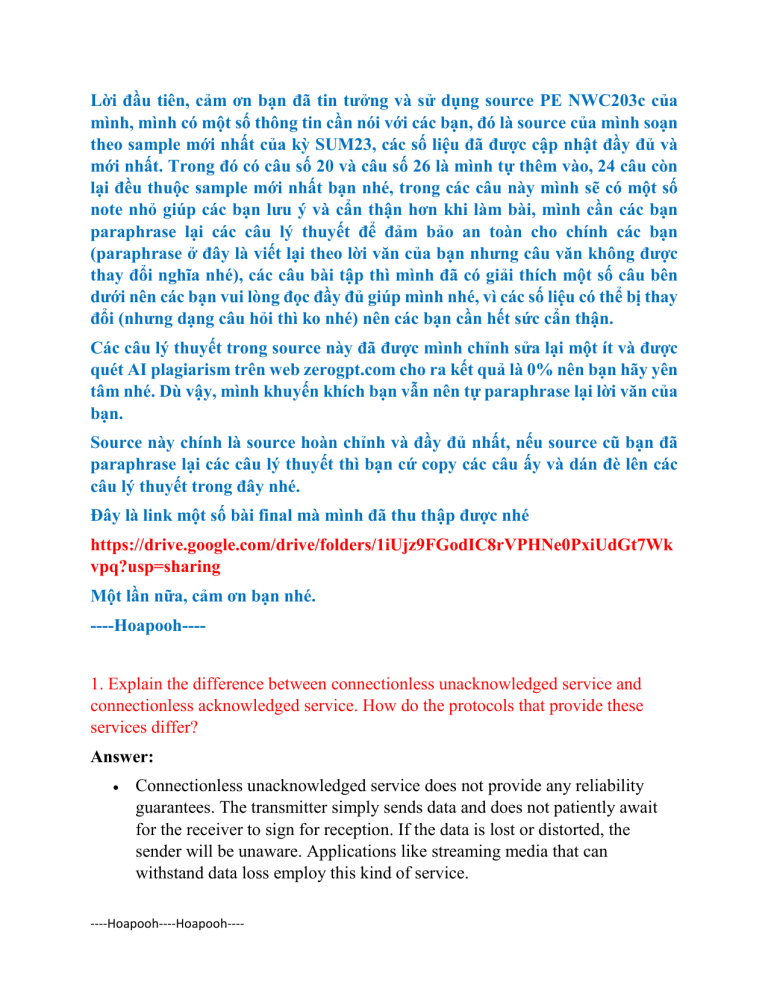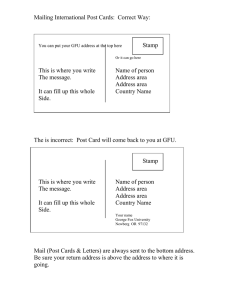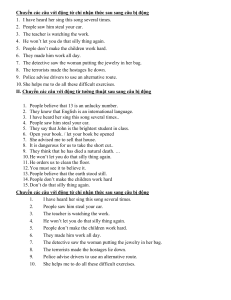
Lời đầu tiên, cảm ơn bạn đã tin tưởng và sử dụng source PE NWC203c của
mình, mình có một số thông tin cần nói với các bạn, đó là source của mình soạn
theo sample mới nhất của kỳ SUM23, các số liệu đã được cập nhật đầy đủ và
mới nhất. Trong đó có câu số 20 và câu số 26 là mình tự thêm vào, 24 câu còn
lại đều thuộc sample mới nhất bạn nhé, trong các câu này mình sẽ có một số
note nhỏ giúp các bạn lưu ý và cẩn thận hơn khi làm bài, mình cần các bạn
paraphrase lại các câu lý thuyết để đảm bảo an toàn cho chính các bạn
(paraphrase ở đây là viết lại theo lời văn của bạn nhưng câu văn không được
thay đổi nghĩa nhé), các câu bài tập thì mình đã có giải thích một số câu bên
dưới nên các bạn vui lòng đọc đầy đủ giúp mình nhé, vì các số liệu có thể bị thay
đổi (nhưng dạng câu hỏi thì ko nhé) nên các bạn cần hết sức cẩn thận.
Các câu lý thuyết trong source này đã được mình chỉnh sửa lại một ít và được
quét AI plagiarism trên web zerogpt.com cho ra kết quả là 0% nên bạn hãy yên
tâm nhé. Dù vậy, mình khuyến khích bạn vẫn nên tự paraphrase lại lời văn của
bạn.
Source này chính là source hoàn chỉnh và đầy đủ nhất, nếu source cũ bạn đã
paraphrase lại các câu lý thuyết thì bạn cứ copy các câu ấy và dán đè lên các
câu lý thuyết trong đây nhé.
Đây là link một số bài final mà mình đã thu thập được nhé
https://drive.google.com/drive/folders/1iUjz9FGodIC8rVPHNe0PxiUdGt7Wk
vpq?usp=sharing
Một lần nữa, cảm ơn bạn nhé.
----Hoapooh---1. Explain the difference between connectionless unacknowledged service and
connectionless acknowledged service. How do the protocols that provide these
services differ?
Answer:
Connectionless unacknowledged service does not provide any reliability
guarantees. The transmitter simply sends data and does not patiently await
for the receiver to sign for reception. If the data is lost or distorted, the
sender will be unaware. Applications like streaming media that can
withstand data loss employ this kind of service.
----Hoapooh----Hoapooh----
Connectionless acknowledged service provides a basic level of reliability by
sending acknowledgments for each data packet. A packet will be resent by
the sender if it doesn't get an acknowledgment the first time. File transfers,
for example, are examples of applications that cannot tolerate data loss.
The protocols that provide these services differ in how they handle
acknowledgments.
Protocols that provide connectionless unacknowledged service do not send
acknowledgments. The sender simply sends the data and does not wait for
any response from the receiver. This type of protocol is simpler and faster
than protocols that provide connectionless acknowledged service.
Protocols that provide connectionless acknowledged service send
acknowledgments for each data packet. The sender waits for an
acknowledgment before sending the next packet. This type of protocol is
more reliable than protocols that provide connectionless unacknowledged
service, but it is also slower.
2. Explain the difference between connection-oriented acknowledged service and
connectionless acknowledged service. How do the protocols that provide these
services differ?
Answer:
Connection-oriented acknowledged service establishes a connection between
the sender and receiver before any data transmission takes place. This
connection is used to track the sequence of data packets and to ensure that
all packets are delivered reliably.
Connectionless acknowledged service does not establish a connection before
data transmission. Instead, each data packet is delivered separately, and the
receiver acknowledges receipt of each packet individually. This service is
less dependable than connection-oriented recognized service, but it is
quicker
The protocols that provide these services differ in how they handle connections
and acknowledgments.
Protocols that provide connection-oriented acknowledged service establish a
connection between the sender and receiver before any data transmission.
----Hoapooh----Hoapooh----
The most common protocol that provides connection-oriented acknowledged
service is the Transmission Control Protocol (TCP).
Protocols that provide connectionless acknowledged service do not establish
a connection before data transmission.
3. Explain the differences between PPP and HDLC
Answer:
HDLC is a short form of High-level Data Link Control that does the data
encapsulation. PPP is an acronym for Point-to-Point Protocol that can be used by
different devices without any data format change.
And below are few differences of HDLC and PPP:
- Configuration type
HDLC is implemented by Point-to-point link configuration and also multi-point
link configurations.
PPP is implemented by Point-to-Point configuration only.
- Layer
HDLC works at layer 2 (Data Link Layer).
PPP works at layer 2 and layer 3 (Network Layer).
- Media Type
HDLC is used in synchronous media.
PPP is used in synchronous media as well as asynchronous media.
- Error detection
HDLC does not offer error detection.
PPP provides the feature of error detection using FCS (Frame Check Sequence)
while transmitting data.
- Authentication
HDLC does not provide link authentication.
PPP provides link authentication using protocols like PAP (Password
Authentication Protocol) and CHAP (Challenge Handshake Authentication
Protocol).
----Hoapooh----Hoapooh----
In general, PPP is a more versatile and secure protocol than HDLC. However,
HDLC is simpler and faster than PPP. The best protocol to use will depend on the
specific needs of the application
4. A 1.5 Mbps communications link is to use HDLC to transmit information to the
moon. What is the smallest possible frame size that allows continuous
transmission? The distance between earth and the moon is approximately 375,000
km, and the speed of light is 3x108 meters/second
(câu này đáp án đã được trình bày công thức đầy đủ và chi tiết bên dưới, các bạn
chỉ cần chú ý các con số khi ra thi để thay đổi khi cần thiết nhé)
Answer:
As Go-Back-N and Selective Repeat are required for both the Default HDLC
Frame and Extended HDLC Frame, it can be described as follows.
Maximum Send Window Size
in Default HDLC Frame
Maximum Send Window Size in
Extended HDLC Frame
7
4
127
64
Go-Back-N
Selective Repeat
As topic, we have Distance and Speed of Light:
D (Distance) = 375,000 km = 375 * 106 (m)
c (Speed of Light) = 3 * 108 (m)
Then, we can compute Round Trip Propagation Delay by this formula:
𝟐𝒕𝒑𝒓𝒐𝒑 =
𝑫
𝒄
=
𝟑𝟕𝟓 𝒙 𝟏𝟎𝟔
𝟑 𝒙 𝟏𝟎𝟖
= 𝟐, 𝟓𝒔
We know that:
𝑵×𝒏𝒇
𝑹
= 𝟐𝒕𝒑𝒓𝒐𝒑 ⇒ 𝒏𝒇 =
𝟐𝒕𝒑𝒓𝒐𝒑 × 𝑹
𝑵
(∗)
In which, 𝑛𝑓 is Possible Frame Size (bits), Mbps is the number of Megabyte Per
Second.
R = 1,5 Mbps so that R = 1,5 x 106 bps.
Go-back-N:
----Hoapooh----Hoapooh----
Default HDLC Frame: N = 7, substitute to (*) then we have
𝟐,𝟓×𝟏,𝟓 ×𝟏𝟎𝟔
𝟕
≈ 𝟓𝟑𝟓𝟕𝟏𝟒 (𝒃𝒊𝒕𝒔)
Extended HDLC Frame: N = 127, substitute to (*) then we have
𝟐,𝟓×𝟏,𝟓 ×𝟏𝟎𝟔
𝟏𝟐𝟕
≈ 𝟐𝟗𝟓𝟐𝟕 (𝒃𝒊𝒕𝒔)
Selective Repeat
Default HDLC Frame: N = 4, substitute to (*) then we have
𝟐,𝟓×𝟏,𝟓 ×𝟏𝟎𝟔
𝟒
= 𝟗𝟑𝟕𝟓𝟎𝟎 (𝒃𝒊𝒕𝒔)
Extended HDLC Frame: N = 64, substitute to (*) then we have
𝟐,𝟓×𝟏,𝟓 ×𝟏𝟎𝟔
𝟔𝟒
≈ 𝟓𝟖𝟓𝟗𝟒 (𝒃𝒊𝒕𝒔)
5. Suppose HDLC is used over a 1.5 Mbps geostationary satellite link. Suppose
that 250-byte frames are used in the data link control. What is the maximum rate at
which information can be transmitted over the link? (cần xem lại)
(câu này vừa rồi xảy ra ko ít tranh cãi, nên mình để 2 đáp án ở đây đề phòng
trường hợp nhé, theo như các admin trong cuộc họp gg meet thì đáp án thứ 2 sẽ
được lựa chọn nhiều hơn, câu này các bạn nên đặc biệt chú ý nhé)
Answer:
The speed of the satellite link is 1.5 Mbps which is equal to 1.5*10 6 bits per
second.
The size of the frame that occurred on the data link line is 250 bytes = 2000 bits.
So under the HDLC protocol, the maximum rate can be calculated by using the
formula given below,
Max rate = speed link * frame size = 1.5*106 * 2000 = 3*109
Thus the maximum rate transmitted over the link is 3*109 bits per second.
Second Answer:
----Hoapooh----Hoapooh----
R = 1.5 Mbps or R = 1,5 x 106 bps , and nf =250 bytes or 2000 bits (250 x 8).
The distance that the information must travel is the earth-to-satellite distance, or D
≈ 36,000 km = 3,6 x 107m .
The speed of light c is 3 x 108 . We can calculate the propagation delay and
processing rate as follows:
𝑡𝑝𝑟𝑜𝑝 =
𝑡𝑓 =
𝐷
𝑐
𝑛𝑓
𝑅
=
3,6×107
=
3×108
2000
1,5×106
= 0,12 𝑠 = 120 𝑚𝑠
= 0,00133 𝑠 = 1,33 𝑚𝑠
We can use either Go-Back-N or Selective Repeat ARQ. The default window size
is N = 7 (with a 3- bit sequence number).
The maximum information rate is achieved with no error, and hence, no
retransmission.
𝑡𝑐𝑦𝑐𝑙𝑒 = minimum time to transmit a group of N packets
= 𝑡𝑓 + 2 𝑡𝑝𝑟𝑜𝑝 = 1.33 + 2 x 120 = 241.33 ms
In which, 𝑡𝑐𝑦𝑐𝑙𝑒 is the minimum time to transmit a group of N packets.
n = no. of bits transmitted in a cycle = N. 𝑛𝑓 = 7 x 2000 = 14000 bits
𝑅𝑚𝑎𝑥 = no. of bits sent in a cycle / minimum cycle time = n / 𝑡𝑐𝑦𝑐𝑙𝑒 = 58 kbps
In which, 𝑛 is number of bits transmitted in a cycle, 𝑅𝑚𝑎𝑥 is number of bits sent in
a cycle / minimum cycle time.
----Hoapooh----Hoapooh----
If the extended sequence numbering option (7-bit) is used, the maximum send
window size would be N = 27– 1 = 127, and hence, the maximum information rate
is:
𝑛 = 𝑁 × 𝑛𝑓 = 127 × 2000 = 254000 𝑏𝑖𝑡𝑠
𝑅𝑚𝑎𝑥 =
𝑛
𝑡𝑐𝑦𝑐𝑙𝑒
=
254000
= 1052,5 𝑘𝑏𝑝𝑠 = 1,0525 𝑀𝑏𝑝𝑠
241,33
6. Suppose that a multiplexer receives constant-length packet from N = 60 data
sources. Each data source has a probability p = 0.1 of having a packet in a given
second period. Suppose that the multiplexer has one line in which it can transmit
eight packets every T seconds. It also has a second line where it directs any packets
that cannot be transmitted in the first line in a T-second period. Find the average
number of packets that are transmitted on the first line and the average number of
packets that are transmitted in the second line.
(câu này các bạn chú ý đơn vị của N và p là ổn nhé, công thức Avg chỉ cần thế số
bấm máy là ổn bạn nhé, có 1 công thức Np ở dưới chỉ đơn giản là N nhân với p
thôi bạn nhé)
Answer:
First, find out the probability of the k packets that have reached the T- second. It
can be computed with the help of binomial distribution that has parameters as
N=60 and shows the probability of p=0.1.
The average number for the arrivals of the packets can be given as Np=6. Now,
calculate the average number of packets received through the first line as below:
8
𝐴𝑣𝑔 = ∑ 𝑘(0.1)𝑘 0.960𝑘 = 4.59
𝑘=0
4.59 is the average number of packets received that gets transmitted through the
first line. The remaining will get transmitted by the second line.
The average number of packets transmitted through the second line per T second =
Np – Avg = 6 – 4.59 = 1.41
So, it will transmit 1.41 packets on average per T second from the second line.
----Hoapooh----Hoapooh----
7. Consider the transfer of a single real-time telephone voice signal across a packet
network.
Suppose that each voice sample should not be delayed by more than 20 ms.
a. Discuss which of the following adaptation functions are relevant to meeting the
requirements of this transfer: handling of arbitrary message size; reliability and
sequencing; pacing and flow control; timing; addressing; and privacy, integrity
and authentication.
b. Compare a hop-by-hop approach to an end-to-end approach to meeting the
requirements of the voice signal.
Answer:
a)
•
Message size is crucial because real-time voice communications need the
delivery of a fixed packet size that can only accommodate speech signals of 20
milliseconds or less. As long as the required speech packet size can be handled, it
is not as crucial how arbitrary message sizes are handled.
•
Sequencing is crucial as every packet must arrive in the order that it was
produced. While voice transmission can withstand a certain amount of error and
loss, reliability is only somewhat critical.
•
Pacing and flow control are less significant because it is assumed that the
end systems' speeds will be same by virtue of the voice signal's synchronous
nature.
•
Timing, for real-time voice transfer is crucial since it assists in reducing the
jitter of the supplied signal through its adaption function.
•
Addressing is just when the connection is being set up, assuming some kind
of virtual circuit packet switching technique.
•
Privacy, integrity, and authentication have typically not been as
significant as the previously mentioned issues.
b)
If the underlying network is trustworthy, end-to-end is preferable since edge
processing is sufficient to deliver respectable performance and the likelihood of
mistake is very low.
----Hoapooh----Hoapooh----
The hop-by-hop technique may be necessary if the underlying network is
unstable. For instance, error recovery at each hop may be required to enable
successful communication if the probability of error is very high, as it is in a
wireless channel.
----Hoapooh----Hoapooh----
8. Consider the Stop-and-Wait protocol as described. Suppose that the
protocol is modified so that each time a frame is found in error at either the
sender or receiver, the last transmitted frame is immediately resent.
a. Show that the protocol still operates correctly.
b. Does the state transition diagram need to be modified to describe the
new operation?
c. What is the main effect of introducing the immediate-retransmission
feature?
Answer:
a/ In the chapter's discussion of the stop-and-wait protocol, the sender resends a
frame if an acknowledgement is not received in a timely manner. Every time a
transmitter or receiver detects an error, according to the updated protocol, the
frame is sent again.
Since frames are retransmitted more frequently, it is the sole change. The protocol
will thus operate as expected.
b/ No. The state transition diagram won’t change.
c/ With this modified protocol, the error recovery procedure will proceed more
quickly.
----Hoapooh----Hoapooh----
9. Suppose that two peer-to-peer processes provide a service that involves the
transfer of discrete messages. Suppose that the peer processes are allowed to
exchange PDUs that have a maximum size of M bytes including H bytes of header.
Suppose that a PDU is not allowed to carry information from more than one
message
Answer:
a. Develop an approach that allows the peer processes to exchange messages of
arbitrary size.
To convert arbitrary sizes, large contents must be split into bytes of each length
that will be transmitted in multiple PDUs.
b. What essential control information needs to be exchanged between the peer
processes?
Peer processes must exchange information that permits messages to be
reassembled at the recipient. The message length, for example, could be included
in the first PDU. A message end-of-message marker could be included in the last
PDU. In connection-oriented networks, sequence numbers can be used to detect
loss, while in connectionless networks, they can be used to aid in message
reconstruction. Finally, because variable-size PDUs are allowed, the PDU size
must be specified in the PDU header.
c. Now suppose that the message transfer service provided by the peer processes is
shared by several message source-destination pairs. Is additional control
information required, and if so, where should it be placed?
In this instance, each PDU must be identified with a stream ID in addition to all of
the header information specified in (b), so that the receiver may treat each stream
separately while reassembling messages.
10. A 1 Mbyte file is to be transmitted over a 1 Mbps communication line that has
a bit error rate of p = 10-6.
a. What is the probability that the entire file is transmitted without errors?
Note for n large and p very small, (1 − p)n ≈ e-np.
b. The file is broken up into N equal-sized blocks that are transmitted
separately. What is the probability that all the blocks arrive correctly without
error? Does dividing the file into blocks help?
----Hoapooh----Hoapooh----
c. Suppose the propagation delay is negligible, explain how Stop-and-Wait
ARQ can help deliver the file in error-free form. On the average how long
does it take to deliver the file if the ARQ transmits the entire file each time?
(Đây là một câu khó nên các bạn chú ý đọc kỹ đề và thay đúng số nếu đề có thay
đổi số liệu nhé)
Answer:
The file length n = 1 Mbyte = 8 Mbit = 8*106 bits, the transmission rate R = 1
Mbps, and p = 10-6.
a.
P[no error in the entire file] = (1 – p)n ≈ e–np , for n >> 1, p << 1
= e-8 = 3.35 x 10-4
We conclude that it is extremely unlikely that the file will arrive error free.
b.
A subblock of length n/N is received without error with probability:
P[no error in subblock] = (1 – p)n/N
A block has no errors if all subblocks have no errors, so
P[no error in block] = P[no errors in subblock]N =((1 – p)n/N)N = (1 – p)n
So simply dividing the blocks does not help.
c.
We assume the following:
• t0 = basic time to send a frame and receive the ACK/NAK ≈ ttimeout
• ttotal = total transmission time until success
• nf = number of bits/frame
• na = number of bits per ACK
• nt = number of transmissions
• Pf = probability of frame transmission error
----Hoapooh----Hoapooh----
t0 = tf + tACK = nf / R + na / R
(tprop ≈ 0).
P[nt = i ] = P[one success after i – 1 failure] = (1 – Pf) P i – 1
f
Ttotal | i transmissions = i.t0
∞
𝑖−1
E[ttotal] = ∑∞
= t0 (1 − Pf)
𝑖=1 𝑖𝑡0 𝑃[𝑛𝑡 = 𝑖] = 𝑡0 (1 − 𝑃𝑓 ) ∑𝑖=1 𝑖𝑃𝑓
= t0(1–Pf )/(1–Pf)2 = t0/(1 - Pf)
Here, nf = n >> na thus t0 ≈ tf = n/R ; and Pf = 1 – P[ no error] = 1 - e-np
E[total] = n/R (1 – Pf) = n/[Re-np] = 8 / (3.35*10-4) = 23,880 seconds ≈ 6.63 hours!
The file gets through, but only after many retransmissions.
11.
In this activity, you are given the network address of 192.168.1.0/24 to subnet and
provide the IP addressing for the Packet Tracer network. Each LAN in the network
requires at least 25 addresses for end devices, the switch and the router. The
connection between R1 to R2 will require an IP address for each end of the link.
a. Based on the topology, how many subnets are needed?
b. How many bits must be borrowed to support the number of subnets in the
topology table?
c. How many subnets does this create?
----Hoapooh----Hoapooh----
d. How many usable hosts does this create per subnet?
Note: If your answer is less than the 25 hosts required, then you borrowed too
many bits.
(Câu này các bạn chỉ copy đáp án ra là ổn nhé, các bạn chú ý ra thi ko copy hình
mình dán ở câu a. nhé, mình chỉ show cho các bạn cách nhận biết thôi ạ)
Answer:
a)
We saw that S1, S2, S3, S4, S0/0/0 are the subnets needed, so total we have a 5
Network so we needed 5 in subnets.
b)
The script itself they mentioned at least 25 addresses for the entry devices such as
or router, so if you have to get this 25 addresses we have to borrow 3 bits
We call N is the number of bits, follow fomula below:
𝟒 × 𝟐𝑵 − 𝟐 ≥ 𝟐𝟓
N is the smallest number that satisfies
We got N = 3.
Explain: 4 because 4 is subnet S1, S2, S3 , S4 not S0/0/0
c)
----Hoapooh----Hoapooh----
We saw that number of bits N = 3, then the number of subnets created are :
𝟐𝑵 = 𝟐𝟑 = 𝟖.
=> The number of subnets created is 8
d)
The number of host is 2𝑁 − 2, where N is the smallest number that satisfies:
𝟐𝑵 − 𝟐 ≥ 𝟐𝟓,
We saw that N = 5, so that number of hosts are
𝟐𝑵 − 𝟐 = 𝟐𝟓 − 𝟐 = 𝟑𝟎
12. Five stations (S1-S5) are connected to an extended LAN through transparent
bridges (B1- B2), as shown in the following figure. Initially, the forwarding tables
are empty. Suppose the following stations transmit frames: S1 transmits to S5, S3
transmit to S2, S4 transmits to S3, S2 transmits to S1, and S5 transmits to S4. Fill
in the forwarding tables with appropriate entries after the frames have been
completely transmitted
----Hoapooh----Hoapooh----
(câu này đáp án đã là chuẩn nhất nên bạn ko cần chỉnh sửa gì nhé, những chỗ
trống không phải mình làm sai hoặc thiếu mà là cái thằng station tại đó không
tìm thấy bạn nhé)
Answer:
Step 1
S1 => S5
Step 2
S3 => S2
Step 3
S4 => S3
Step 4
S2 => S1
Step 5
S5 => S4
Step 1
S1 => S5
Step 2
S3 => S2
----Hoapooh----Hoapooh----
B1
Address Port Explaination
Because there is S1 sent. So B1 will
S1
1
receive this packet
Since S3 sends the broadcast, B1
S3
2 receives
it.
Because after step 2, B2 knows that S3
is on port 2, it will forward the packet
S4
2 to port
2. And of course, both S3 and port 2 of
B1 will also receive it.
Since S2 sends the broadcast, B1
S2
1 receives
it.
B2 already knows that S4 is on network
3, so B2 will no longer forward the
packet to networks 2 and 1. So this step
B1 won't say
where S5 is
B2
Address Port Explaination
Because in the beginning, there is S1
sending S5. But both B1 and B2 do not
know where S5 is, so the packet that S1
S1
1 sends is a broadcast. B1 will also
forward the packet because it doesn't
know where S5 is => B2 will receive it
and know that S1 is on port 1
Because there is a session sending S3 to
S3
1 S2, but since S3 doesn't know where S2
is initially, it sends it as a broadcast. And
Step 3
S4 => S3
Step 4
S2 => S1
Step 5
S5 => S4
S4
2
S5
2
so, B2 can also receive the packet of S3,
so B2
can also understand that S3 is on its port
1.
Because S4 sent to S3
After step 1, B1 already knows that S1
is on network 1, so it will not forward
the packet anymore. So at this step, B2
doesn't know where S2 is.
Because S5 sends a broadcast
13. Consider the network in Figure
(câu này là chuẩn nhất nên các bạn cứ copy paste thoải mái nhé)
Answer:
a) Use the Dijkstra algorithm to find the set of shortest paths from node 4
to other nodes.
Iteration
N
Initial
{4}
1
{4,2}
2
{4,2,3}
3
{4,2,3,5}
4
{4,2,3,5,6}
5
{4,2,3,5,6,1}
----Hoapooh----Hoapooh----
D1 D2 D3 D5 D6
∞
∞
∞
∞
∞
(5,4) (1,4) (2,4) (3,4) ∞
(4,2) --- (2,4) (3,4) ∞
(4,2) ----- (3,4) (3,3)
(4,2) ------- (3,3)
(4,2) ---------
b) Find the set of associated routing table entries (Destination, Next Hop,
Cost)
Destination
D1
D2
D3
D5
D6
Cost
4
1
2
3
3
Next Hop
D2
D2
D3
D5
D3
14.
You are a network technician assigned to install a new network for a customer.
You
must create multiple subnets out of the 192.168.0.0/24 network address space to
meet
the following requirements:
- The first subnet is the LAN-A network. You need a minimum of 50 host IP
addresses.
- The second subnet is the LAN-B network. You need a minimum of 40 host
IP addresses.
- You also need at least two additional unused subnets for future network
expansion.
Note: Variable length subnet masks will not be used. All of the device subnet
masks
should be the same length.
----Hoapooh----Hoapooh----
Answer the following questions to help create a subnetting scheme that meets the
stated
network requirements:
a. How many host addresses are needed in the largest required subnet?
b. What is the minimum number of subnets required?
c. The network that you are tasked to subnet is 192.168.0.0/24. What is the /24
subnet mask in binary?
d. The subnet mask is made up of two portions, the network portion, and the host
portion. This is represented in the binary by the ones and the zeros in the subnet
mask
In the network mask, what do the ones and zeros represent?
e. When you have determined which subnet mask meets all of the stated network
requirements, derive each of the subnets. List the subnets from first to last in the
table. Remember that the first subnet is 192.168.0.0 with the chosen subnet mask
(trong câu này, đối với câu c. /?? subnet mask ở đây rất dễ để nhận biết trong giao
thức IPv4, nó sẽ có phương thức hiển thị là w.x.y.z, mỗi vị trí ở trong đây tương
đương với 8 bits trong binary, mình lấy ví dụ, nếu đề bài cho là /12 subnet mask
thì mình sẽ có đáp án là 11111111.11110000.00000000.00000000, ở đây mình sẽ
có 12 số 1 (hoặc 12 bits) tương đương với /12 subnet mask và đối với trong bài
này /24 subnet mask thì bạn hiểu đơn giản sẽ có 24 số 1 (24 bits) và các vị trí
trống ở sau toàn bộ đều là số 0 - 11111111.11111111.11111111.00000000)
(đặc biệt đối với câu e, mình sẽ giải thích đơn giản cho các bạn hiểu về bước nhảy
mạng, cách tìm số subnet, số host mà mỗi subnet có được:
trong bài này số subnet có được là 4 và chúng ta cần tìm là số bit phần Host cho
phần Net mượn
- số subnet có được: 2n (n: số bit phần Host cho phần Net mượn), đối
với bài này ta đã biết số subnet có được là 2n = 4 Ta sẽ tìm được
n = 2, ban đầu các mạng này là /24 subnet mask, sau khi tìm được số
bít phần Host cho phần Net mượn thì ta thêm 2 bit đó vào(2 bit được
thêm vào bạn hiểu đơn giản là thay thế bằng số 1) và nó sẽ trở thành
/26 subnet mask: 11111111.11111111.11111111.1100000000.
- số host trong mỗi mạng con: 2m – 2 (m: là số bit 0 còn lại trong
Subnet mask), trong bài mình sẽ còn lại 6 bit 0 thì mình sẽ có 26 – 2 =
64.
----Hoapooh----Hoapooh----
- số bước nhảy: k = 28-n (n: số bit phần Host cho phần Net mượn),
chúng ta sẽ tìm được k = 28-2 = 64.
và để hình thành ra cái bảng ở câu e, chúng ta chỉ cần điền subnet id đầu tiên vào,
để tìm những subnet id tiếp theo bạn chỉ cần cộng tiếp với 64
subnet ID1: 192.168.0.0 / 26
subnet ID2: 192.168.0.64 / 26 (cộng thêm 64 từ subnet ID1)
subnet ID3: 192.168.0.128 / 26 (cộng thêm 64 từ subnet ID2)
subnet ID4: 192.168.0.192 / 26 (cộng thêm 64 từ subnet ID3)
Answer:
a)
50 Hosts addresses are needed in the largest required subnet.
b)
The requirements stated above specify two company networks for future
expansion. So, there are a 4 minimum number of subnets required.
c)
the /24 subnet mask in binary is 11111111.11111111.11111111.00000000 .
d)
Ones in the binary is represented the network portion.
Zeros in the binary is represented the host portion.
e)
Subnet Address
192.168.0.0
192.168.0.64
192.168.0.128
192.168.0.192
----Hoapooh----Hoapooh----
Prefix
/26
/26
/26
/26
Subnet Mask
255.255.255.192
255.255.255.192
255.255.255.192
255.255.255.192
15. Suppose that Selective Repeat ARQ is modified so that ACK messages contain
a list of the next m frames that it expects to receive.
a. How does the protocol need to be modified to accommodate this change?
b. What is the effect of the change on protocol performance?
Answer:
a. There are two things needed to be changes:
First, the frame header needs to be modified to accommodate the list of frames to
receive. It can be a fixed or a variable number of slots. NAK won’t be necessary
because the receiver explicitly indicates which frames need to be transmitted.
Second, the transmitter operation must change to retransmit frames according to
the received list. If the list contains the m oldest frames that are yet to be received,
then the list can be used to skip retransmissions of frames that have already been
received.
b. Performance will surely increase if the error rate is high or delay is high. A
single frame can ask for the retransmission of several frames
The performance will increase in cases with high error rate or in cases where the
delay is high. A single frame can ask for the retransmission of several frames. The
drawback is the overhead in the header and the increased protocol complexity
relative to pure Selective-Repeat ARQ.
16. Suppose the size of an uncompressed text file is 1 megabyte
Note: Explain your answer in details.
a. How long does it take to download the file over a 32 kilobit/second modem?
b. How long does it take to take to download the file over a 1 megabit/second
modem?
c. Suppose data compression is applied to the text file. How much do the
transmission
times in parts (a) and (b) change?
If we assume a maximum compression ratio of 1:6, then we have the following
times for the 32 Kb and Mb lines respectively
trong câu này, mình đưa ra cho bạn 2 lựa chọn
----Hoapooh----Hoapooh----
- đối với câu trả lời số 1, đơn vị megabyte, megabit và kilobit sẽ được
mình làm tròn đến con số thông dụng nhất, ở đây mình sẽ lấy 1
megabytes = 1,000,000 bytes và chuyển từ byte sang bits thì mình
nhân với 8 (1 byte = 8 bits)
- đối với câu trả lời số 2, mình sẽ lấy chuẩn đơn vị đo lường quốc tế bạn
nhé, mình sẽ có 1 megabytes = 1,048,576 bytes và chuyển từ byte
sang bits thì mình nhân với 8 (1 byte = 8 bits)
Bạn có thể lựa chọn 1 trong 2 cách đều được nhé, mình thì recommend đáp án số 2
nhé.
Answer:
To calculate the download time, we need to convert the file size from megabytes to
kilobits.
a. Download time over a 32 kilobit/second modem:
File size: 1 megabyte = 1,000,000 bytes = 8,000,000 bits = 8,000 kilobits
Download speed: 32 kilobits/second
Download time = File size / Download speed = 8,000 kilobits / 32
kilobits/second = 250 seconds
b. Download time over a 1 megabit/second modem:
File size: 1 megabyte = 1,000,000 bytes = 8,000,000 bits = 8 megabits
Download speed: 1 megabit/second
Download time = File size / Download speed = 8 megabits / 1
megabit/second = 8 seconds
c. If we assume a maximum compression ratio of 1:6, then we have the following
times for the 32 kilobit and 1 megabit lines respectively:
Then 1 megabyte will be compressed into 1/6 megabyte.
1 megabyte = 1,000,000 bytes = 8,000,000 bits = 8,000 kilobits = 8 megabits
T32K = 8000 kilobits / (6*32) kilobits/second ≈ 41,67 secconds.
T1M = 8 megabits / (6 * 1) megabits ≈ 1,33 seconds.
----Hoapooh----Hoapooh----
Second Answer:
To calculate the download time, we need to convert the file size from megabytes to
kilobits.
a. Download time over a 32 kilobit/second modem:
File size: 1 megabyte = 1,048,576 bytes = 8,388,608 bits = 8,388.608
kilobits
Download speed: 32 kilobits/second
Download time = File size / Download speed = 8,388.608 kilobits / 32
kilobits/second = 262.144 seconds
b. Download time over a 1 megabit/second modem:
File size: 1 megabyte = 1,048,576 bytes = 8,388,608 bits = 8.388608
megabits
Download speed: 1 megabit/second
Download time = File size / Download speed = 8.388608 megabits / 1
megabit/second = 8.388608 seconds
c. If we assume a maximum compression ratio of 1:6, then we have the following
times for the 32 kilobit and 1 megabit lines respectively:
Then 1 megabyte will be compressed into 1/6 megabyte.
1 megabyte = 1,048,576 bytes = 8,388,608 bits = 8,388.608 kilobits = 8.388608
megabits
T32K = 8,388.608 kilobits / (6*32) kilobits/second ≈ 43,69 secconds.
T1M = 8.388608 megabits / (6 * 1) megabits ≈ 1,39 seconds.
17. Let g(x)=x3+x+1. Consider the information sequence 1001. Find the codeword
corresponding to the preceding information sequence. Using polynomial arithmetic
we obtain
trong bài này G là generator polynomial (đa thức sinh) và D là chuỗi Data)
----Hoapooh----Hoapooh----
- các bạn lưu ý, đa thức sinh (G) phải có độ dài bé hơn hoặc bằng độ dài
của chuỗi Data (D), phải bắt đầu và kết thúc bằng bit 1. ví dụ G =
10011 (đúng), G = 11010 (sai vì bit cuối khác 1).
thêm bao nhiêu số ko vào cuối chuỗi Data (D) thì bạn sẽ lấy số lượng bit trong đa
thức sinh (G) – 1, trong bài này, mình gọi n là số lượng bit trong G mình sẽ có n
= 4, và sẽ bit 0 mình cần thêm vào cuối chuỗi Data (D) là n – 1 = 4 – 1 = 3.
Lúc chia thì bạn chia bit Data mới (new D) cho G.
Answer:
G = x3+x+1 or we can write in binary is 1011.
D = 1001.
Step 1: Add 000 to data bits string. It will be 1001000
Step 2: Devide 1001000 to 1011 in modulo – 2 method.
1001000
1011
1011
----001000
1010
⊕
⊕
1011
----00110 110 is FCS
So the codeword = 1001110
18. A router has the following CIDR entries in its routing table:
Address/mask Next hop
135.46.56.0/22 Interface 0
135.46.60.0/22 Interface 1
192.53.40.0/23 Router 1
default
Router 2
(a) What does the router do if a packet with an IP address 135.46.63.10 arrives?
(b) What does the router do if a packet with an IP address 135.46.57.14 arrives?
----Hoapooh----Hoapooh----
trong câu này bạn đổi tất cả các con số ra dạng nhị phân nhé
đối với máy 570VN Bạn bấm mode rồi bấm số 4 để vào dạng chuyển đổi
decimal và binarry nhé, bạn quan tâm 2 cái này cho mình là được
đối với máy 580VN Bạn bấm menu rồi bấm số 3
để chuyển đổi decimal qua binary thì bạn chú ý các nút trên máy tính cầm tay nhé
(trên máy tính cầm tay các bạn tìm giùm mình những nút DEC HEX BI OCT gần
nhau là được nhé), bấm số bên decimal sau đó bấm dấu “=” rồi bấm qua binary là
được nhé
sau khi đã đổi hết số sang binary, bạn sẽ dùng phép so sánh AND
0 và 0 là 0
1 và 0 là 0
0 và 1 là 0
1 và 1 là 1
trong bài này thì bạn so sánh /23 subnet mask trước (vì nó lớn nhất), khi chuyển
đổi xong bạn so sánh với các con số có sẵn trong đề bài có trùng hay không, nếu ko
có trong /23 thì bạn so sánh tiếp với /22 là được bạn nhé. Trong bài thì câu a) so
sánh với /23 thì cho ra kết quả ko trùng với đề bài còn /22 thì trùng với Interface 1
và cứ so sánh như vậy với câu b) là được bạn nhé.
Answers:
a)
First, the router will check the routing entry starting with the longest prefix (/23)
135.46.63.10 AND 255.255.254.0 = 135.46.62.0 != 192.53.40.0 therefore this
entry does not match.
Next longest prefix is 22: 135.46.63.10 AND 255.255.252.0 =135.46.60.0.
Therefore this packet will routed out over Interface 1.
b)
Similarly, the router will check the routing entry starting with the longest prefix
(/23) 135.46.57.14 AND 255.255.254.0 = 135.46.56.0 != 192.53.40.0 therefore this
entry does not match.
Next longest prefix is 22: 135.46.57.14 AND 255.255.252.0 = 135.46.56.0
Therefore this packet will routed out over Interface 0.
----Hoapooh----Hoapooh----
19. A Large number of consecutive IP address are available starting at 198.16.0.0.
Suppose four organizations, A, B, C, D request 4000, 2000, 4000, and 8000
addresses, respectively. For each of these organizations, give:
1. the first IP address assigned
2. the last IP address assigned
3. the mask in the w.x.y.z/s notation
The start address, the ending address, and the mask are as follows:
(câu này mình hướng dẫn khá kỹ và có công thức trong câu trả lời nên các bạn cần
chú ý các số liệu nhé)
Answers:
Organization A (4000 IP addresses)
Host ID: 12 bits (212= 4096 >=4000)
-> Network ID = 20 bits
The first IP address:
11000110.00010000.00000000.00000000 -> 198.16.0.0
The last IP address:
11000110.00010000.00001111.11111111 - >198.16.15.255
The mask: 198.16.0.0/20 (The first IP address + “/” + Network ID)
Organization B (2000 IP addresses)
Host ID: 11 bits (211= 2048 >=2000)
-> Network ID = 21 bits
The first IP address:
11000110.00010000.00010000.00000000 -> 198.16.16.0 (Add 1 from the last IP
of Organization A)
The last IP address:
11000110.00010000.00010111.11111111 - >198.16.23.255
----Hoapooh----Hoapooh----
The mask: 198.16.16.0/21 (The first IP address + “/” + Network ID)
Organization C (4000 IP addresses)
Host ID: 12 bits (212= 4096 >=4000)
-> Network ID = 20 bits
The first IP address:
11000110.00010000.00100000.00000000 -> 198.16.32.0 (Add 1 from the last IP
of Organization B)
The last IP address:
11000110.00010000.00101111.11111111 - >198.16.47.255
The mask: 198.16.32.0/20 (The first IP address + “/” + Network ID)
Organization D (8000 IP addresses)
Host ID: 13 bits (213= 8192 >=8000)
-> Network ID = 19 bits
The first IP address:
11000110.00010000.01000000.00000000 -> 198.16.64.0 (Add 1 from the last IP
of Organization C)
The last IP address:
11000110.00010000.01011111.11111111 - >198.16.95.255
The mask: 198.16.64.0/19 (The first IP address + “/” + Network ID)
20.The ability to work with IPv4 subnets and determine network and host
information based on a given IP address and subnet mask is critical to
understanding how IPv4 networks operate. The first part is designed to reinforce
how to compute network IP address information from a given IP address and
----Hoapooh----Hoapooh----
subnet mask. When given an IP address and subnet mask, you will be able to
determine other information about the subnet.
Fill out the tables below with appropriate answers given the IPv4 address, original
subnet mask, and new subnet mask
(đây là câu mình tự thêm vào nên mang tính chất tham khảo là chính, nhưng
bạn vẫn nên đọc hết cách làm của nó nhé)
Answer:
Number of subnet bits:
Original Subnet Mask: 255.255.255.0 (24 bit-1s)
New Subnet Mask: 255.255.255.248 (29 bit-1s)
Number of Subnet bits: 5 (29 - 24)
Number of subnet created:
2number of subnet bits = 25 = 32
Number of host bits per subnets
32 – (number of network bits) – (number of subnet bits)
= 32 – 24 – 5 = 3
Number of hosts per subnet
2Host bits - 2= 23 - 2 = 6 (-2: Network address, Broadcast address)
----Hoapooh----Hoapooh----
Network Address of this Subnet
11000000.10000111.11111010.10110100 (Host IP Address)
11111111.11111111.11111111.11111000 (New Subnet mask)
(Host IP Address) AND (New Subnet mask)
11000000.10000111.11111010.10110000 = 192.135.250.176
Câu 21:
Suppose an application layer entity wants to send an L-byte message to its peer
process, using an existing TCP connection. The TCP segment consists of the
message plus 20 bytes of header. The segment is encapsulated into an IP packet
that has an additional 20 bytes of header. The IP packet in turn goes inside an
Ethernet frame that has 18 bytes of header and trailer. What percentage of the
transmitted bits in the physical layer correspond to message information, if L = 100
bytes, 500 bytes, 1000 bytes.
(câu này thì bạn chú ý xem kỹ số liệu và đọc kỹ đề là được bạn nhé)
Anwser: Because the message overhead includes – TCP’s header: 20 bytes; IP
packet’s header: 20 bytes and Ethernet frame’s header and trailer: 18 bytes.
Therefore, if an message consists of L byte length so that the total bytes of that
message now is L + 20 + 20 + 18 = L + 58.
The percentage of the transmitted bits in the physical layer correspond to message
information is p = [L/(L+58)]*100.
When :
+ L = 100 bytes p ≈ 63.29%.
+ L = 500 bytes p ≈ 89.61%.
+ L = 1000 bytes p ≈ 94.52%.
Câu 22:
----Hoapooh----Hoapooh----
Consider the three-way handshake in TCP connection setup.
(a) Suppose that an old SYN segment from station A arrives at station B,
requesting a TCP connection. Explain how the three-way handshake
procedure ensures that the connection is rejected.
(b) Now suppose that an old SYN segment from station A arrives at station B,
followed a bit later by an old ACK segment from A to a SYN segment from
B. Is this connection
Answer:
a) In three-way handshake, to identify which connection is rejected or accepted,
the initial sequence number is always unique. If B receives an old SYN segment
form A, B will acknowledged the request base old sequence number. When A
receives the acknowledge message from B, A will know B used the wrong initial
sequence number and discard it then reset the connection.
b) First of all, B recieves an old SYN segment, B will send a SYN segment with its
own unique sequence number set by B. If B receives the old ACK from A, B will
inform A that the connection is invalid since the old ACK sequence numbers does
not match the sequence number previously defined by B. Therefore, the connection
is rejected.
Câu 23:
Suppose a header consists of four 16-bit words: (11111111 11111111, 11111111
00000000, 11110000 11110000, 11000000 11000000). Find the Internet checksum
for this code.
trong câu này các bạn bấm máy tính nhé, bạn chuyển qua dạng chuyển đổi và tập
trung vào binary giùm mình thôi nhé (cách chuyển đổi mình đã ghi ở câu 18), ở
đây là checksum nên bạn cứ cộng hết vào cho mình, sau đó bạn sẽ ra đáp á giống
như hình bên dưới, bạn chú ý giùm mình 2 dòng cuối nhé, khi cộng xong bạn cứ
ghi hết tất cả các bit ra cho mình (giống như mình trình bày ở trong bài), bài này
chỉ cho 16 bit nên bạn đếm từ cuối chuỗi đến con số thứ 16 là bạn dừng và lấy các
con số đó, các số trước đó (carry bit – số mà mình bôi đỏ trong bài) thì bạn giữ lại
(ko được tự ý bỏ đi) rồi tiếp tục cộng với chuỗi hiện tại. Để chắc cú thì bạn hãy
bấm máy tính giùm mình nhé.
----Hoapooh----Hoapooh----
Tiếp đến, để tìm Internet checksum thì nó chỉ đơn giản là 1’s complement hay hiểu
đơn giản là lật ngược chuỗi 0 đổi thành 1 và 1 đổi thành 0. Ví dụ: 1010 đổi
thành 0101, 1001 0110.
Answer:
11111111 11111111
+
11111111 00000000
+
11110000 11110000
+
11000000 11000000
------------------------1110110000 10101111
(here we have 11 is a carry-bit, so to maintain the bit string is 16 bit length, we
need to add 11 to the current bit string 10110000 10101111). Let’s continue with
the sum calculate:
10110000 10101111
+
11
----Hoapooh----Hoapooh----
------------------------10110000 10110010
And now to find the Internet checksum, we need to use 1’s complement for the
above bit string.
10110000 10110010
1’s complement: 01001111 01001101
So the Internet Checksum is: 01001111 01001101
Câu 24:
Consider the 7-bit generator, G=10011, , and suppose that D has the value
1001010101. What is the value of R? Show your all steps to have result.
(câu này giống như câu 17 bạn nhé) R ở đây là remainder (phần còn lại) bạn nhé, là
cái giống mình làm trong bài nhé
G = 10011
D = 1001010101
- step 1: We need to add four 0 at the end of D => 10010101010000
- step 2: Now we divide new D to G
10010101010000
⊕
10011
1000110000
10011
------000011010
⊕
10011
------010011
⊕
10011
------000000000 => Now we get the remain is : 0000
So the value of R is 0000.
Câu 25:
----Hoapooh----Hoapooh----
Suppose two hosts, A and B, are separated by 20,000 kilometers and are connected
by a direct link of R = 2 Mbps. Suppose the propagation speed over the link is 2.5
x 108 meters/sec.
a. Calculate the bandwidth-delay product, R_prop.
b. Consider sending a file of 800,000 bits from Host A to Host B. Suppose the file
is sent continuously as one large message. What is the maximum number of bits
that will be in the link at any given time?
(câu này công thức mình đã ghi rất chi tiết nên bạn cần chú ý đọc kỹ đề nhé, đối
với câu b) thì bạn chỉ cần lấy giá trị của bandwidth-delay product điền vào là được,
bài này mình tính ra 160000 bits thì ở câu b) mình đổi đơn vị và ghi thành 160
kilobits).
ANSWER:
distance between A and B: 2*107 m
tranmission rate: R = 2*106 bits/s
propagation delay: 2,5*108 m/s
a) R_dprop = distance / propagation delay = 2*107 / 2,5*108 = 0,08s
bandwidth-delay product = R * R_dprop = 2*106 * 0,08 = 160000 bits
b) Send a file from Host A to Host B: 800000 bits.
When you send a file from A to B, you need to split data into packets, each
packets has 160 Kilobits.
Câu 26. (optional question) Sender A wants to send 100111010011011 to receiver
B. This transmission uses CRC algorithm for error detection with generator
polynomial bits string is 10111. What is bits string will be transmitted on the
medium. Show your all steps to have result.
(bài này giống như bài 17 bạn nhé) – đây là câu mình tự thêm vào nên cũng chỉ
mang tính chất tham khảo bạn nhé, nhưng bạn vẫn nên đọc để hiểu thêm nhé
First add 0000 to data bits string. It will be 1001110100110110000.
Next, we divide 1001110100110110000 to 10111 to get remainder.
1001110100110110000
----Hoapooh----Hoapooh----
10111
⊕
101010001000110
10111
------0010010
⊕
10111
------0010110
⊕
10111
------000010110
⊕
10111
-------000011100
⊕
10111
------010110
⊕
10111
------000010
And here, we have our remainder is 10, but we need 4 bit string so it need to
be 0010 FCS is 0010
Therefore, transmitted bits string is 1001110100110110010.
----Hoapooh----Hoapooh----






